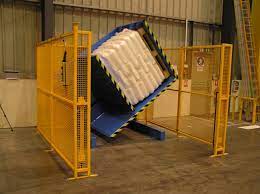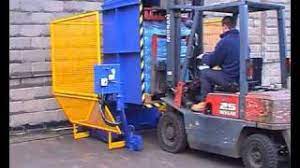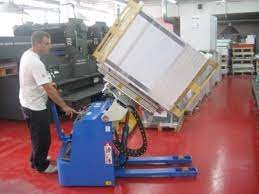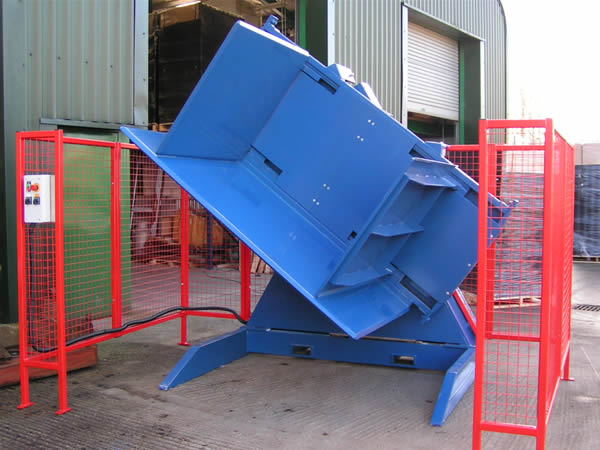Why Are Spain's Manufacturers Replacing Manual Handling with Pallet Inverters?
Are you watching your team manually transfer heavy loads from one pallet to another? You probably see the physical strain, the slow pace, and the occasional damaged product. These small, everyday issues seem manageable, but they add up to significant hidden costs, safety risks, and operational bottlenecks. What if there was a way to eliminate these problems, speed up your entire logistics chain, and protect both your employees and your bottom line? Many Spanish manufacturers are discovering this solution, and it's simpler than you might think.
Spanish manufacturers are replacing manual handling with pallet inverters to drastically increase operational speed, enhance worker safety, and reduce product damage. These machines automate the process of transferring goods between pallets, eliminating the physical labor and risks associated with manual methods. This shift leads to higher productivity, lower operational costs, and improved supply chain efficiency, which are critical for staying competitive in today's market.

As an engineer who has spent his entire career on the factory floor, I understand the pressure to keep operations moving smoothly. I've seen firsthand how a seemingly small process, like transferring goods from a wooden pallet to a plastic one for cleanroom use, can become a major headache. The good news is that understanding the reasons behind this technological shift is the first step toward solving these challenges in your own facility. Let's explore the specific drivers pushing Spain's industrial leaders toward this powerful automation.
How do pallet inverters directly impact operational safety?
Does your factory still rely on workers physically lifting and restacking heavy boxes or bags to switch pallets? You see your team working hard, but you also worry about the risk of injury with every lift. An accident can mean lost workdays, insurance claims, and a drop in team morale, creating a problem that affects the entire production line. Imagine a workplace where these risks are virtually gone, where your team is safer and your operations are more secure.
Pallet inverters directly impact operational safety by completely removing the need for manual lifting and handling of heavy goods during pallet exchange. The machine securely clamps the entire load, rotates it, and allows for the old pallet to be removed and a new one to be placed, all without a single employee having to bear the weight. This automation prevents musculoskeletal injuries, which are the most common and costly type of workplace injury in manufacturing.

Deconstructing the Safety Benefits
When I started as a young engineer, one of the first things I learned was that the most dangerous tasks are often the most repetitive. Manual pallet handling is a perfect example. It's not a single heavy lift that causes the problem, but hundreds of them, day after day. This repetitive strain is what leads to long-term, debilitating injuries. A pallet inverter isn't just a piece of equipment; it's an engineering control that designs the hazard out of the process.
Eliminating Manual Handling Risks
The primary safety benefit is the elimination of manual handling. This single change addresses a wide range of physical risks. Workers no longer need to bend, twist, and lift heavy items. This is crucial in industries where individual products can weigh 25kg or more. The machine takes on the entire load, which can be over 1,000kg. This immediately reduces the risk of common injuries.
- Musculoskeletal Disorders (MSDs): These include back injuries, shoulder strain, and carpal tunnel syndrome. They are caused by repetitive motion and heavy lifting. A pallet inverter does the heavy work, so your team doesn't have to.
- Slips, Trips, and Falls: Manual destacking can lead to scattered products on the floor, creating tripping hazards. An inverter keeps the load contained, maintaining a clear and safe work area.
- Falling Object Hazards: When stacking manually, there is always a risk of an unstable load collapsing or a single box falling. The inverter's clamping system holds the entire load securely during the transfer process.
A Comparative Look at Risk
Let’s be direct. The difference between manual and automated pallet exchange is stark. Thinking about it in a structured way makes the choice clear for any factory manager focused on long-term stability.
| Safety Factor | Manual Pallet Handling | Handling with a Pallet Inverter |
|---|---|---|
| Ergonomic Strain | High risk of back, shoulder, and wrist injuries. | Minimal. The operator uses simple controls. |
| Falling Product Risk | Moderate to high, depends on load stability. | Very low. The load is clamped securely. |
| Worker Fatigue | High. Physical exertion leads to reduced focus. | Low. The machine does the physical work. |
| Cycle Speed | Slow and variable, dependent on worker stamina. | Fast and consistent, typically under 60 seconds. |
| Injury-Related Costs | High potential for medical bills and lost time. | Drastically reduced insurance and compensation costs. |
By investing in a pallet inverter, Spanish manufacturers are not just buying a machine. They are investing in a safer work environment. This leads to a healthier, more productive workforce and protects the business from the significant financial and operational disruptions that workplace injuries can cause.
You look at your budget and see the direct labor costs for your logistics team. But are you accounting for the expenses that don't show up on that line item? The cost of a damaged shipment, the spike in your insurance premium after a minor injury, the production delays caused by a slow pallet-swapping process—these are the hidden costs. They slowly eat away at your profit margins, turning what seems like a cost-saving measure into a significant financial drain.
The hidden costs of manual pallet handling extend far beyond direct wages. They include expenses from product damage during transfer, increased insurance premiums due to higher injury risks, and significant productivity losses from slow, inefficient processes. Furthermore, costs associated with employee turnover and training for physically demanding roles add to this financial burden, making manual methods far more expensive than they appear.

Uncovering the True Financial Impact
I remember working with a client in Mexico, a steel mill owner named Javier. He was brilliant, a man who knew his factory inside and out. He prided himself on running a lean operation. He was hesitant about investing in a pallet inverter because he saw his team handling pallet transfers and thought, "It's working. Why change?" But when we sat down and started calculating the real costs, his perspective shifted completely.
Beyond the Obvious Labor Cost
Every factory owner, like Javier, tracks direct labor. But the true cost of a process is often buried in other departments' budgets. Let's break down where the money is really going with manual pallet handling.
- Product Damage: This is a huge one. When a worker is manually moving items, especially heavy sacks of cement or boxes of fragile tiles, drops happen. Even a small drop can break a product or tear a bag. If you have a 1% damage rate on a €1,000 pallet, that's €10 lost. If you transfer 50 pallets a day, that's €500 lost daily. A pallet inverter handles the entire load as a single, stable block, reducing damage rates to nearly zero.
- Worker Compensation and Insurance: This is a silent profit killer. In Spain, like most of Europe, workplace safety regulations are strict. A single back injury claim can cost tens of thousands of euros in medical bills, lost wages, and administrative fees. More importantly, your company's insurance premiums are directly tied to your safety record. Fewer injuries mean lower premiums, a saving that continues year after year.
- Operational Inefficiency: How long does it take two workers to manually unstack and restack a pallet? 15 minutes? 20 minutes? A pallet inverter can do the same job in about 60 seconds. This time saving is massive. It means your forklift and operator aren't waiting. Your shipping truck isn't idle at the loading dock. The entire workflow speeds up, allowing you to move more products with the same number of people.
A Cost Comparison
When Javier and I put the numbers into a simple table, the business case became undeniable.
| Cost Category | Manual Handling (Annual Estimate) | Pallet Inverter (Annual Estimate) | Annual Savings |
|---|---|---|---|
| Damaged Goods | €15,000 | €500 | €14,500 |
| Injury-Related Costs | €10,000 (avg.) | €0 | €10,000 |
| Lost Productivity | €25,000 (idle time) | €0 | €25,000 |
| Total Hidden Costs | €50,000 | €500 | €49,500 |
This simple analysis doesn't even include the benefits of higher employee morale and lower turnover. By automating, Spanish manufacturers are cutting these hidden costs, and the savings go directly to the bottom line. It turns a capital expenditure into a high-return investment.
How does a pallet inverter improve product quality and reduce waste?
You take pride in the quality of your products, but what happens in the last 100 meters of your production line? A product can be perfectly manufactured but then get damaged or contaminated during final handling and shipping preparation. Manual restacking can lead to crushed boxes, torn bags, and dirty packaging, forcing you to scrap or repackage goods. This waste costs money and can even damage your brand's reputation if a subpar product reaches the customer.
A pallet inverter improves product quality by providing a gentle, controlled method for handling goods. It eliminates the risks of dropping, crushing, or contaminating products that are common with manual restacking. By clamping the entire load and rotating it smoothly, the machine ensures that every item, from the top to the bottom of the pallet, is transferred without damage, preserving the integrity and value of the final product.

Protecting Your Product's Integrity
From my experience designing packing solutions, I can tell you that product protection is everything. It doesn't matter how great your product is if it arrives broken. This is especially true for manufacturers in Spain who export high-value goods like wine, olive oil, or pharmaceuticals. The final handling stage is a critical quality control point. A pallet inverter acts as a guardian of that quality.
From Manufacturing to Shipping Dock
The journey of a product is not complete until it is safely loaded for transport. Manual handling introduces many variables that can compromise quality.
- Preventing Physical Damage: Imagine a pallet of ceramic tiles. Manually moving these boxes puts immense pressure on the bottom layers, risking cracks and breakage. A pallet inverter supports the entire stack's weight, preventing this compression damage. Similarly, for bagged goods like grain or cement, manual hooks and rough handling can cause tears. The inverter’s wide, flat clamping platens distribute pressure evenly, protecting the packaging.
- Ensuring Cleanliness and Hygiene: In the food, beverage, and pharmaceutical industries, hygiene is non-negotiable. Often, goods must be moved from a standard wooden pallet to a sanitized plastic or metal pallet for entry into a cleanroom environment. Manually doing this risks introducing contaminants like wood splinters, dust, or bacteria from the floor. A pallet inverter performs this transfer in a closed, controlled manner, keeping the products pristine.
- Enabling Quality Control Checks: What if you need to check a product at the bottom of a pallet? Manually, you would have to unstack the entire load. This is slow and risks damaging other items. With an inverter, you can simply invert the load, remove the top pallet, and have immediate access to the bottom layer for inspection. This makes quality control faster and more thorough.
The Impact on Waste Reduction
Reducing waste is not just about cost; it's about efficiency and sustainability. Here's how an inverter directly contributes to less waste.
| Source of Waste | Manual Handling Process | Pallet Inverter Process |
|---|---|---|
| Product Breakage | High risk due to drops and compression. | Very low risk due to secure, even clamping. |
| Packaging Damage | High risk of torn bags and crushed boxes. | Minimal risk. The machine is gentle on packaging. |
| Contamination | Moderate risk, especially for food/pharma. | Low risk. Provides a clean transfer. |
| Repackaging Labor | Significant time spent fixing damaged loads. | Minimal to no time needed for repackaging. |
For Spanish manufacturers, quality is a key competitive advantage. A pallet inverter is a strategic tool to protect that advantage all the way to the customer's door. It's a final check to ensure that the hard work and precision of the manufacturing process are not undone in the final moments of handling.
How do pallet inverters contribute to a more sustainable supply chain?
Your company, like many in Spain and across the EU, is facing increasing pressure to be more sustainable. Customers demand it, and regulations require it. You might be focused on big initiatives like reducing energy consumption or emissions, but what about the waste generated in your logistics? Broken wooden pallets, discarded packaging, and inefficient transport all have an environmental footprint. These small areas of waste can add up, undermining your company's green credentials.
Pallet inverters contribute to a more sustainable supply chain by enabling the easy recovery and reuse of pallets, reducing the need to discard damaged ones. They also help minimize product waste by preventing damage during handling. This leads to less landfill waste from both pallets and products. Additionally, by facilitating load consolidation and optimization, they can lead to more efficient transportation, which lowers fuel consumption and carbon emissions.

Building a Greener Logistics Operation
When I discuss equipment with factory owners like Javier, the conversation often turns to long-term value. Today, sustainability is a core part of that value. A machine is no longer judged just on its output, but on its overall impact. A pallet inverter is a surprisingly powerful tool for improving the environmental performance of a factory's logistics. It's a practical step toward a circular economy model within your own four walls.
Key Areas of Sustainability Impact
The contribution of a pallet inverter to sustainability can be broken down into a few key areas. Each one helps manufacturers meet both regulatory requirements and customer expectations.
- Pallet Recovery and Reuse: This is the most direct environmental benefit. Companies often receive goods on low-quality or one-way pallets. Instead of shipping out on these same pallets, they prefer to use their own higher-quality, internal pallet pool. A pallet inverter allows for the quick transfer of goods, freeing up the incoming pallet. This allows companies to either return cheap pallets to the sender or, if they are damaged, consolidate them for recycling instead of sending them to a landfill. It also extends the life of their own high-quality pallets.
- Reduction of Product Waste: As we've discussed, pallet inverters significantly reduce product damage. Every product that is not thrown away is a win for sustainability. This means the raw materials, energy, and water used to create that product are not wasted. For food products, this is especially critical in the fight against food waste.
- Optimized Transportation: Pallet inverters can be used to consolidate loads. For example, two half-full pallets can be combined into one full pallet. This maximizes the space used in a transport truck. Fuller trucks mean fewer journeys are needed to transport the same amount of goods. Fewer journeys mean less fuel consumed and lower carbon emissions.
The Sustainability Scorecard
Let's look at the direct environmental benefits in a clear format.
| Sustainability Metric | Manual Handling Impact | Pallet Inverter Impact |
|---|---|---|
| Pallet Waste | Higher; damaged pallets are often discarded. | Lower; enables pallet recovery and reuse programs. |
| Product Waste | Higher due to frequent handling damage. | Lower due to safe, automated handling. |
| Resource Consumption | Higher; wasted products mean wasted resources. | Lower; preserves finished goods. |
| Carbon Footprint | Higher due to potential for inefficient transport. | Lower by enabling load consolidation. |
For manufacturers in Spain, who are part of the EU's ambitious Green Deal, these operational improvements are not just "nice to have." They are becoming essential for doing business. A pallet inverter provides a clear, measurable way to make logistics more sustainable, helping companies build a stronger, more responsible brand.
Conclusion
In short, Spanish manufacturers adopt pallet inverters for a simple reason: they provide a total solution for safety, efficiency, quality, and sustainability, delivering a powerful return on investment.



